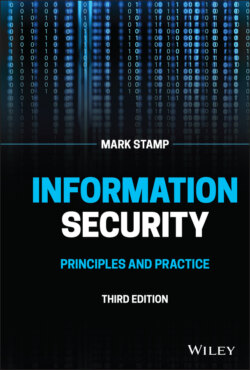Читать книгу Information Security - Mark Stamp - Страница 35
2.3.4 Double Transposition Cipher
ОглавлениеIn this section we discuss another classic cipher that illustrates some important basic concepts. The double transposition presented here is a weaker form of the usual double transposition cipher. We use this form of the cipher since it provides a slightly simpler means of illustrating all of the points that we want to make.
To encrypt with a double transposition cipher, we first write the plaintext into an array of a given size and then permute the rows and columns according to specified permutations. For example, suppose we write the plaintext attackatdawn into a array
If we transpose (or permute) the rows according to and transpose the columns according to , we obtain
The ciphertext is read from the final array as
(2.3)
For this double transposition cipher, the key consists of the row and column permutations. Anyone who knows the key can simply put the ciphertext into the appropriate sized matrix and undo the permutations to recover the plaintext For example, to decrypt (2.3), the ciphertext is first put into a array. Then the columns are numbered as and rearranged to , and the rows are numbered and rearranged into ,
and we see that we have recovered the plaintext, attackatdawn .
The bad news is that, unlike a simple substitution, the double transposition does nothing to disguise the letters that appear in the message. The good news is that the double transposition appears to thwart an attack that relies on the statistical information contained in the plaintext, since the plaintext statistics are dispersed throughout the ciphertext.
Even this simplified version of the double transposition is not entirely trivial to break. The idea of smearing plaintext information through the ciphertext is so useful that it is employed by modern block ciphers, as we will see in the next chapter.
